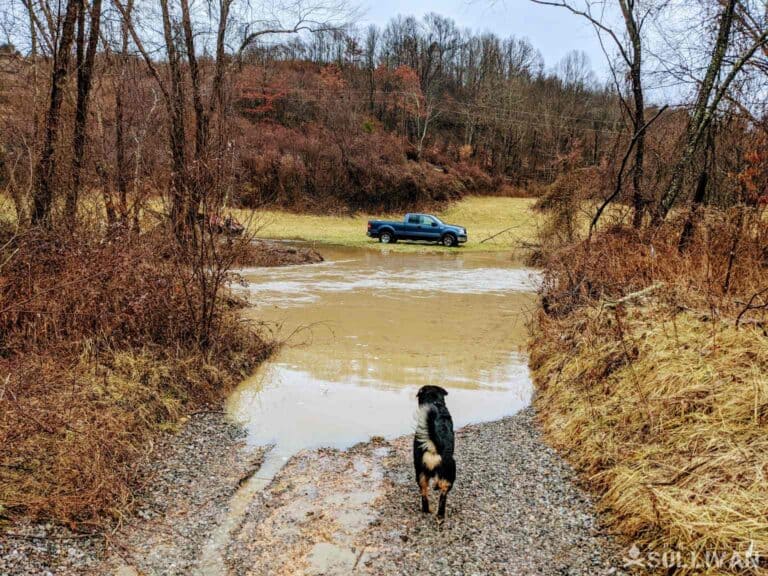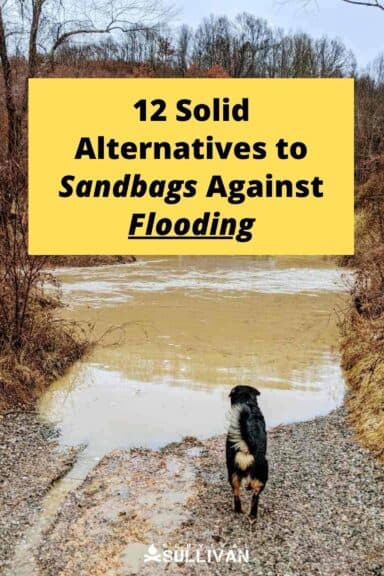Floods are among the most common and devastating disasters that can befall people anywhere around the world. The rule of thumb is that anywhere it can rain, it can flood, and your flood risks are geometrically worse in areas of high precipitation, near any body of water concourse, or in a low-lying area.

Even minor flooding can ruin your home and possessions, and severe flooding can devastate entire regions, often killing dozens or hundreds of people.
Floods seem like one of those things that you just have to endure or escape from, but with the right approach and enough time to react that isn’t necessarily true.
It’s always possible to sandbag properties to reduce flood damage by redirecting water or holding it at bay. But filling sandbags is highly laborious and often cannot be done in time.
Luckily, there are functional alternatives to traditional sandbags. Some of them use the floodwater itself to provide that protection. I’ll tell you about some good sandbag alternatives below in the rest of this article…
[TAG1]
Aqua Dams
Aqua dams, alternatively cold hydro dams or water dams, are basically humongous, flexible tubular, or pad-shaped containers that use the weight of water to hold back even bigger quantities of water. Basically, they are water-inflated containers that look like a giant water pack or ice pack once they are full.
[TAG2]
Made by various manufacturers, a large and properly sited aqua dam can hold back a truly gargantuan amount of water, as much as 6 feet or a little more. It is one the very best options for protecting flood-vulnerable waterways or properties, and they are reasonably easy to move into place with a team of men or a vehicle.
However, they take a long time to fill in order to render maximum protection, and specialized pumping rigs are needed to fill them from nearby water sources or the flood water itself.
Concrete / Cement Bags
One of the most interesting, and divisive, improvised methods for flood defense on our list here is concrete or cement bags. When you think about it, they work kind of like sandbags, right?
I mean they’re flexible, they can hold back water and the fill even reacts with water. What could be better?
Properly placed, concrete or cement bags will definitely hold back water, and as the water activates the mix inside it’s going to get even stronger!
Yes, this is undoubtedly true, but the problem comes when it’s time to clean up: you’re going to have an impossibly heavy and durable concrete wall to deal with! Or, at best, a mass of concrete right in front of your door, garage or anywhere else you happen to place it.
I don’t much look forward to the notion of jackhammering or sledgehammering that concrete into chunks and then carting it away, but I suppose if the alternative is losing my home and everything in it, or using concrete and cement bags because I had them close at hand, I would choose the latter…
Garbage Bags
Flood waters rising? No sandbags? No problem! They are janky and prone to damage, but it is entirely possible to make functional sandbag equivalents using garbage bags alone. If you have them, heavy-duty contractor-grade cleanup bags are best.
Even better, garbage bags are waterproof and you can fill them with water and then tie them off to use them like miniature aqua dams, though they have a tendency to drift away if not secured. But filled with sand, clean dirt, or even clay you can use them as normal.
I wouldn’t trust them in cases of the most severe flooding, but for shoring up defenses at doorways, windows, garages, and so forth they can work pretty well.
“Sandless” Sandbags
Another “non-sandbag” sandbag, if you don’t think it that way, this flood protection device, as popularized by Quick Dam and other brands, is small, self-contained, and a truly fast and efficient method of placing flood defensive barriers where they’re needed.
[TAG3]
These ingenious bags are full of a hydrophilic powder that absorbs water and rapidly swells to many times its original size, in essence giving you something that looks, feels, and behaves like a sandbag with no filling and no backbreaking labor needed. Definitely a nice perk!
The only downside is that they are not reusable, being a one-and-done measure for flood protection. They also tend to be a little expensive.
Nonetheless, they are a wonderful option, especially for folks who constantly deal with flash floods or just don’t have it in them to do much manual labor in an emergency.
Cofferdams
Cofferdams are an extremely old but time-tested technology for resisting floodwaters, or any kind and amount of water.
A cofferdam is essentially a walled structure that can be made from any suitably durable material, including metal, masonry, wood, and others. It’s anchored in place partially by water on the “wet” side and then by braces, joists, or pilings on the other.
[TAG4]
If you’ve ever seen “wet” construction work, such as around bridges, pilings, piers, dry docks, and so forth, you’ve seen coffer dams before.
They are undeniably effective and can hold back a ton of water, but if they’re not pre-placed, or if anchor points are not pre-installed and ready to accept them, they generally take too long to set up and assemble to be effective when time is short.
As a long-term defensive option in a flood-prone area, though, they work quite well.
Flex Walls
Flex walls are exactly what they sound like, a heavy-duty rubberized synthetic barrier that can be set up ahead of a flood in order to protect structures from water intrusion.
Like aqua dams, flex walls use the force of the water in operation, holding the material down horizontally and vertically as the water presses against them.
[TAG5]
The biggest advantage of this type of system is that it can fold up into a very small, very light, and compact package that is easy to stow and easy to transport, and the wall itself can be had in many different sizes to protect from minor flooding or major flooding.
The limitation of a flex wall is that it must be propped up against a solid abutment to function. That means against a building wall or even against a cofferdam in some cases if you want to use it away from a structure.
Floodgates
Floodgates, sometimes known as flood barriers, are metallic paneling systems that are designed to be installed on building fronts, doors, and other entryways where flooding is anticipated or historically a known problem.
They’re installed and held up by attached braces that mount onto temporary or permanent anchor points nearby.
So long as the infrastructure needed to mount the floodgates is already installed on the building and ground nearby, they can be very quick and easy to install with just one or two people and appropriate, basic hand tools.
They work fine for protecting buildings against rising water, but these gates are not a great choice for any location that might be battered by onrushing water; they can buckle under enough force, damaging and breaking windows and doors behind them.
Hydra-Barrier
No, it isn’t a barrier to protect you from a multi-headed snake monster. The Hydra-Barrier markets itself as an environmentally friendly, reusable alternative to traditional sandbags for modest flood protection around residential and light commercial structures.
[TAG6]
Very light and very easy to place, if you’ve got a working garden hose or some other reliable source of water nearby before the flooding gets too bad you are in business: simply unroll them, put them in place around your entire house, and then fill them up- easy as that.
Depending on the size of the model you chose, a Hydra-Barrier can protect your property from anywhere from 4 to 20 inches of water.
Flood Sax
The confusingly named Flood Sax sandbag alternative is not an instrument, but is instead another so-called “sandless sandbag” that looks almost identical to a genuine sandbag: Size, shape, and even feel.
[TAG7]
Although they are one of the more expensive varieties on the market, Flood Sax has a major advantage in that the granular fill they contain reacts with water and turns into a sort of gel.
This means they remain very heavy and dense, and can be easily molded, sculpted, crammed and shaped to serve any defensive purpose.
his is one product that can protect even the most irregular openings against water.
Best of all, when they aren’t activated they are far, far lighter than an actual filled sandbag, and also a lot smaller. A few crates of these on hand and you can be a one-man flood defense detail!
Snake Bags
Snake bags are really a subtype of traditional sandbag, though they’re so radically different in form factor and application I’m putting them as a separate entry on our list here.
Snake bags are only for light or incidental flooding, no more than a few inches of water at the absolute most. That’s because snake bags are basically an incredibly long sock! That’s about how big they are in overall diameter when filled…
You feel snake bags with sand just like you would normal sandbags, and then place them where they are needed to hold water back or direct it.
They can help you in cases of minor flooding like serious thunderstorms or flash floods, and that can also save the flooring and other fixtures in your home if your piping, faucet, tub, or toilet springs a leak.
Compared to traditional sandbags, they are much faster to fill, easier to handle, and easier to store.
Absorbees / Door Defenders
Absorbees is the brand name for a sandbag alternative that’s generically called “door defenders.”
You’ve probably seen these in use in commercial buildings and light industrial installations for quickly cleaning up and protecting against leaks, floods, and major spills.
They look sort of like a giant sausage, and when they are placed, after coming into contact with water, they swell up quickly.
They work by absorbing liquid like the name suggests, facilitating cleanup, and once full, they become a barrier that will hold back further liquid.
This is another great product that’s extremely easy to use and effective against light flooding or the ingress of water from spills and other accidents.
The downsides are that they’re only good for protecting relatively small areas like doors and other entryways, and general expense.
Sorbarix
More of an emergency water cleanup tool than a true flood defense one, Sorbarix bags are unique because they are paper thin and totally flat when not activated.
But when you toss one onto a large spill or standing water, it will guzzle up an astounding 23 liters worth of fluid, with most of that being sucked up in less than half a minute! Amazing!
This makes rapidly cleaning up water- before it can do lots of damage- a snap, and though it isn’t going to protect your property or your home in its entirety from flooding, if you have a few failures in your defensive perimeter this is the perfect product to help you make quick work of it.

The post 12 Solid Alternatives to Sandbags Against Flooding appeared first on Survival Sullivan.
By: Tom Marlowe
Title: 12 Solid Alternatives to Sandbags Against Flooding
Sourced From: www.survivalsullivan.com/sandbags-alternatives/
Published Date: Wed, 10 Jan 2024 10:22:06 +0000
------------------------
Did you miss our previous article...
https://bushcrafttips.com/bushcraft-news/exploring-simpleshots-slingshots-review-and-class-experience
 What is BushcraftSurvival SkillsToolsVideosBushcraft CampsBushcraft KitsBushcraft ProjectsPrivacy PolicyTerms And Conditions
What is BushcraftSurvival SkillsToolsVideosBushcraft CampsBushcraft KitsBushcraft ProjectsPrivacy PolicyTerms And Conditions
